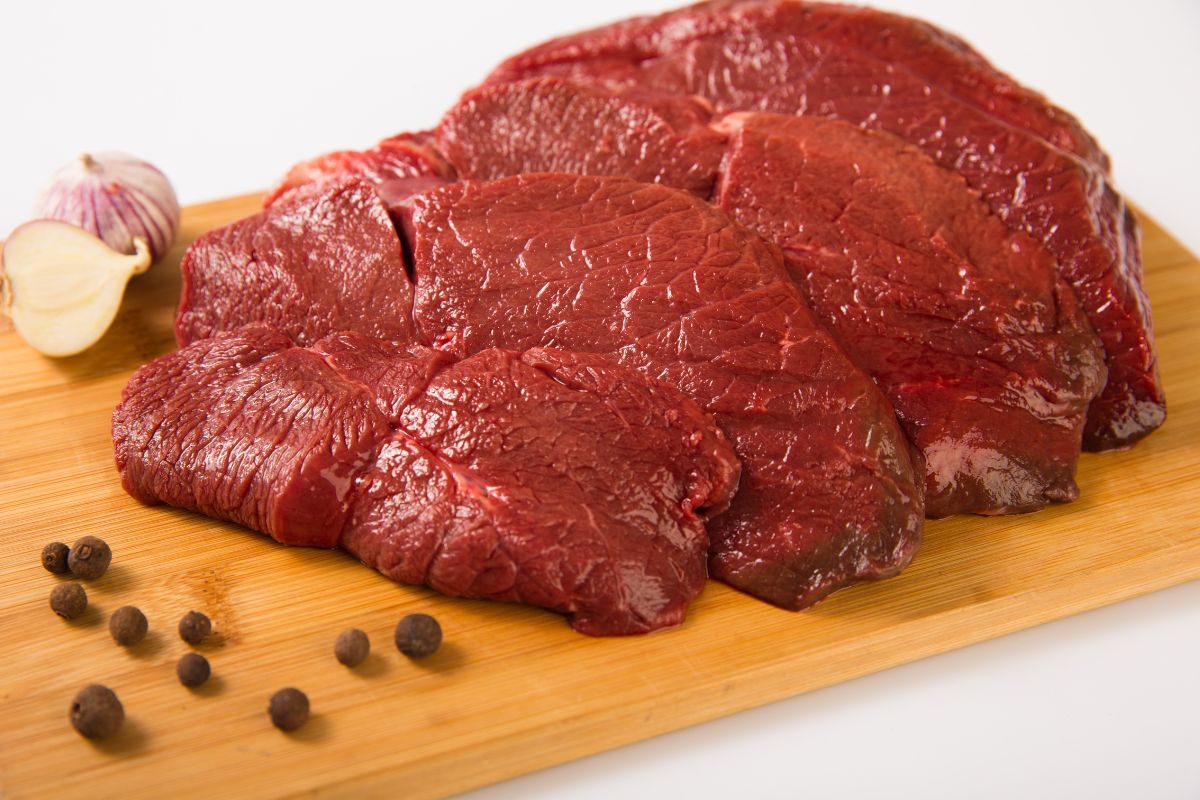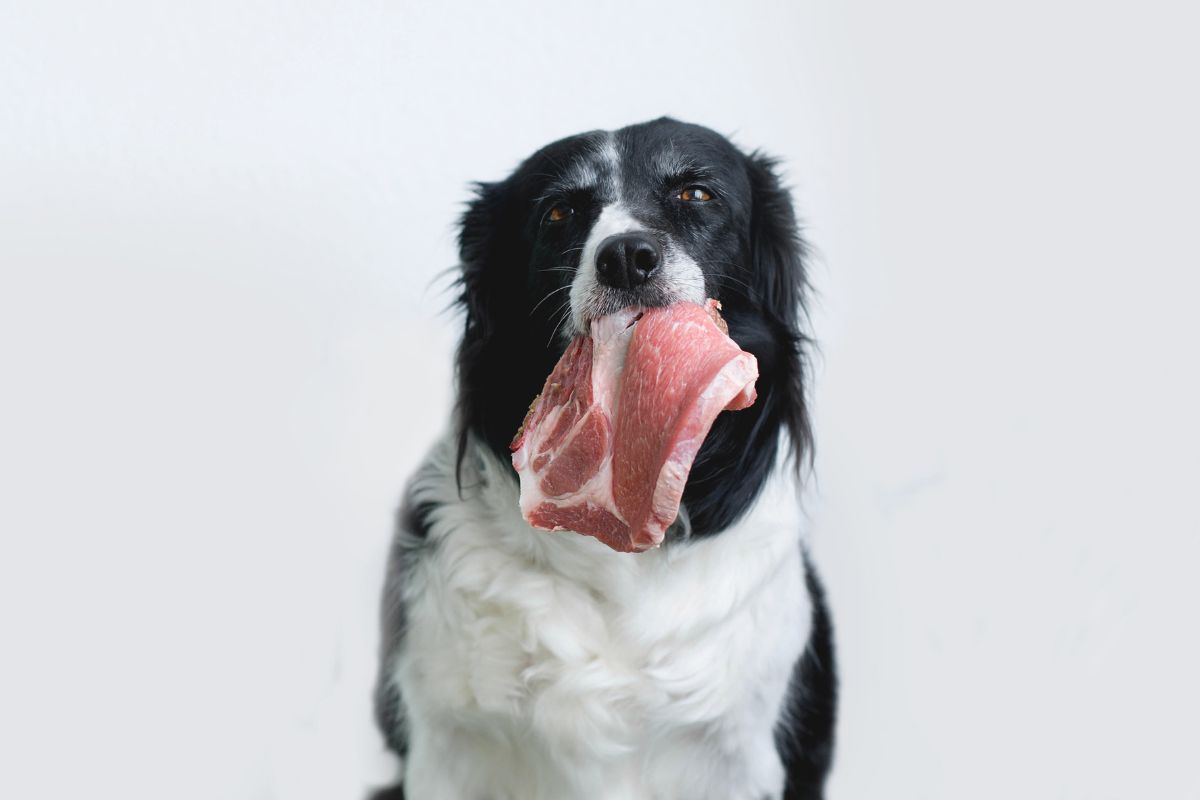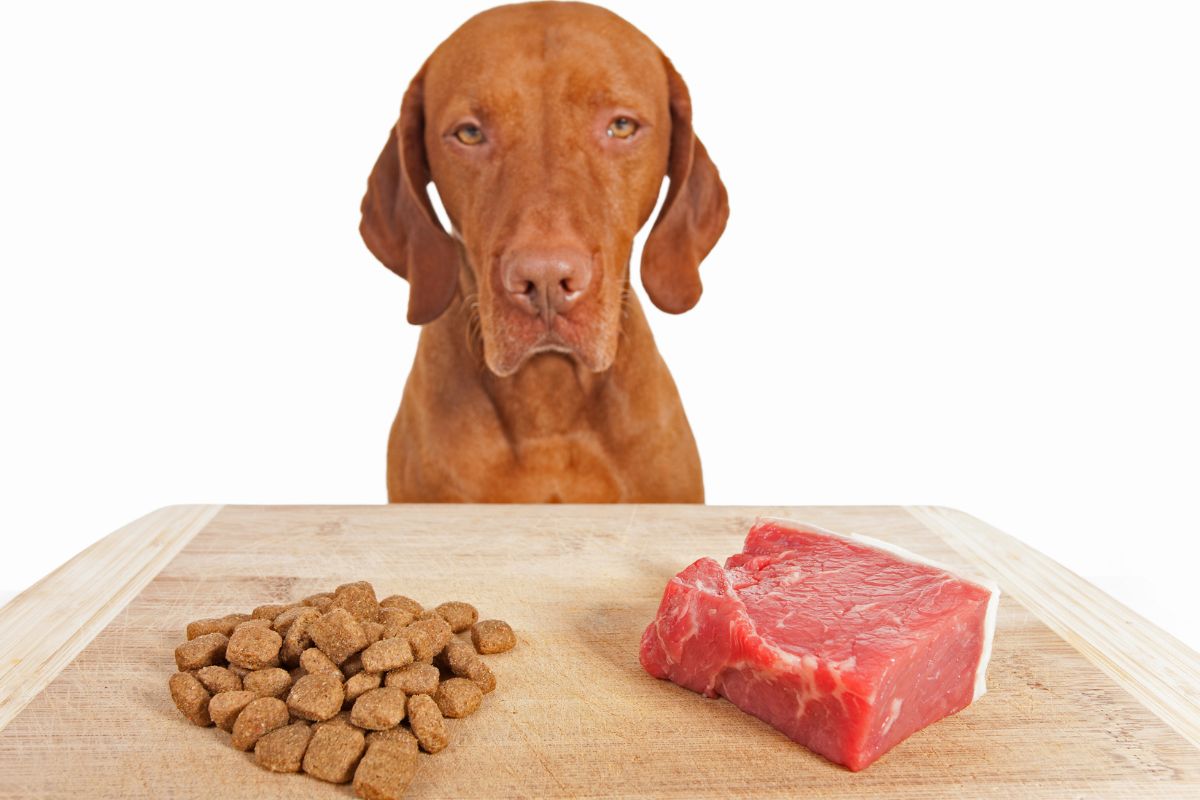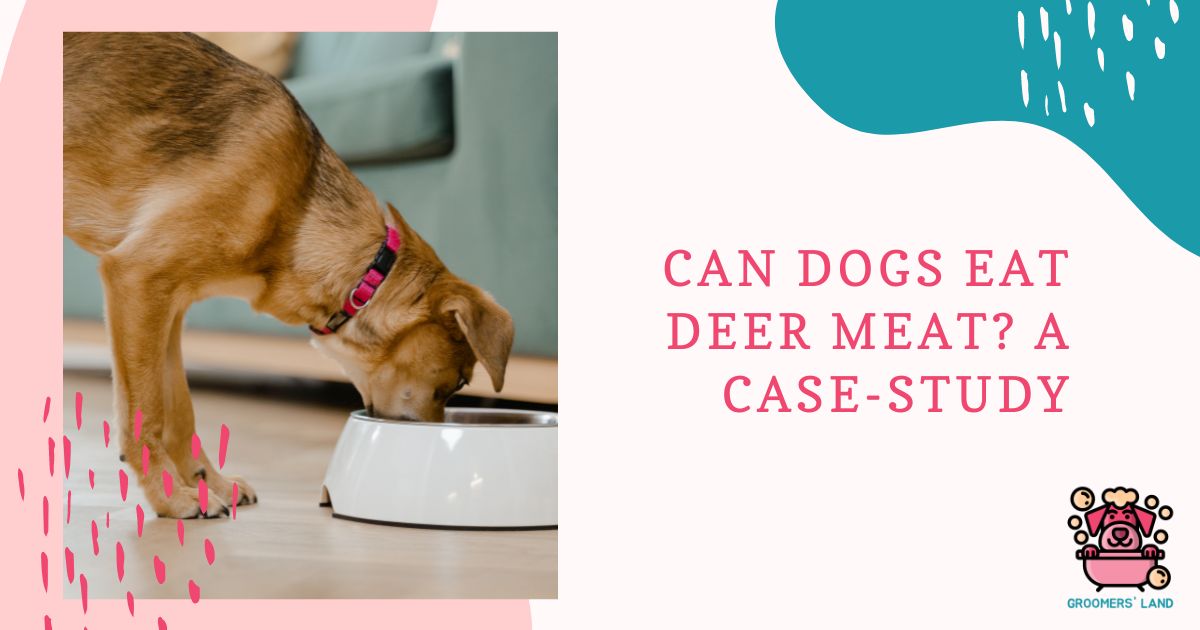Is Venison Good for Dogs?
You may be asking yourself, can dogs eat deer meat? Manufacturers of pet food frequently employ venison, and for a good reason. Comparing deer meat to other common pet food meats like beef or chicken, it has less fat and cholesterol. Venison-based pet foods are a great option for dogs that may be sensitive to or allergic to other protein sources like chicken or beef.

Can Dogs Eat Deer Meat?
Many ask, can dogs eat venison? Venison or deer meat is frequently used in pet food production and is a popular ingredient in dog food.
There is some debate over whether deer meat is safe for dogs. Canines benefit from venison (deer meat), a common alternative. Even though it can harbor bacteria if not handled properly, venison is a decent option for a meal with a lot of raw meat.
To kill bacteria, you should boil or freeze the venison before giving it to your dog. Ensure that the venison jerky you feed your dog is from pure protein sources rather than many additives. Veal sausages are a popular treat that can be good for your dog, but you should only give them in moderation because many producers add a lot of fat to their sausages.
You may feed your dog liver and heart as part of a raw diet because they are both healthful meats. However, excessive liver feeding can cause health problems in some dog species, such as Dalmatians. Dogs can benefit from consuming raw bones as a treat or as an addition to their usual raw diet.
However, you should use caution when handling cooked bones because they are more prone to splinter in your dog’s mouth. Most owners prepare meals for their dogs regularly. A venison dish calls for 2 cans of broth, 5 pounds (2.3 kilograms) of deer, 4 cups of water, 3 pounds (1.4 kilograms) of brown rice, and three cans of corn.
Can Dogs Have Deer Bones?
The advantages of giving your dog bones as rewards in terms of health and safety are a hot contest among dog owners. Let’s examine whether giving your dog deer bones is a good idea.
Uncooked Venison Bones
Adding bones to raw dog food gives your dog a lot of beneficial vitamins. Your dog can consume raw bones without any problems, but the most crucial thing is to ensure your bones’ source is secure. As a result, you can give your raw dog bones; they make a tasty complement to their regular meals.
However, if you give them food as a reward, pay attention to the source and never leave them alone with a bone.
Bones of Cooked Venison
Only boiled bones are the only kind of cooked bones that are safe for dogs. More cooked foods have a higher chance of splintering in your dog’s mouth and can harm their mouth and throat in several ways. Additionally, cooked bones lose some nutrients during cooking, making them less healthy than raw ones. If you must feed your dog cooked bones, ensure you boil them.
Is Deer Meat Good for Dogs?
Is venison good for dogs? Canines benefit from eating venison (deer meat), which is a common alternative. With the correct handling, venison is a decent option for a diet that includes a lot of raw meat. To kill bacteria, you should boil or freeze the venison before giving it to your dog.
Venison is a rich source of B vitamins and minerals like zinc, phosphorus, and iron. Many dogs enjoy its flavor, which supports healthy energy levels in dogs. Venison-based pet foods are a great option for dogs that may be sensitive to or allergic to other protein sources like beef or chicken.
What is Venison Meal?
Venison meal, a meat concentrate with a higher protein content than fresh venison, is a component of pet food products. Dogs’ homemade raw-food diets can include venison, but consult your veterinarian before switching your dog to a raw-food diet.
Due to the unusual protein in venison, it may help pets with eating disorders by reducing allergies and skin irritations.
Top Reasons to Feed a Dog Venison Dog Food
In dog food, venison is not usually a protein source. It nevertheless ranks among the most nutrient-rich foods for your dog. Many dog food producers decide not to include venison as an option because of the higher price of the meat and the potential for more financial gain from alternative protein sources.
However, premium dog food manufacturers provide the finest nutrition before generating a profit. Here are a few reasons to choose a dog food made with venison.
Venison Offers More Nutrients for Your Dog
The nutrients in venison support your dog’s overall health and happiness. Deer meat is rich in B vitamins, providing your dog the energy they need. To maintain a healthy organ and immune system function, dog chow produced with venison also contains the right amount of zinc and iron.
Venison is the Best Protein for Dogs With Food Allergies
Some canines have food allergies to well-known proteins like chicken or beef. The symptoms of a dog food allergy include itchy skin, dermatitis, and gastrointestinal issues, including diarrhea or vomiting. Read our article and find out The Best Food For Pitbulls With Skin Allergies.
Dogs get exposure to excessive amounts of chicken or beef when such protein sources are the main element in dog treats and meals. Venison can be a great option if your dog has food allergies or sensitivities.
A Leaner Alternative is Dog Food Made With Venison
If your dog is obese or overweight, switching to venison-based dog food can be the best solution. Deer meat is leaner and lower in fat and cholesterol than other protein sources. By helping your dog maintain their appropriate weight, venison can reduce its risk of developing heart disease and other weight-related health problems.
Dogs Enjoy the Taste of Venison
If your dog has never had dog food made with venison, they could think it’s a tasty treat. Try venison if your dog is picky about what they eat. Even the most selective dogs appear to enjoy the taste of deer flesh.
Can Canines Get Sick From Raw Deer Meat?
Feeding venison to your dog carries hazards, just like any other uncooked meat. Because there is a remote possibility that kids may be allergic to meat, you should always introduce new meals gradually.
Additionally, there is a chance that the meat still has bacteria. Because of this, it is good to freeze the raw meat for at least 24 hours before defrosting it and giving it to your dog. This helps to eradicate any bacteria.

Which Deer Products are Safe for Dogs to Eat?
You might be wondering what portions of a deer you can feed your pet now that we know that venison is healthy and safe meat for your dog. The advantages and drawbacks of providing your dog with particular varieties of deer meat are below.
Venison Jerky
Dogs frequently receive jerky as a gift, but is venison jerky healthy for them? Being selective when purchasing venison jerky is important because it can be a fantastic treat for your dog. If the jerky is from a single source of protein and is naturally dry, it is a completely nutritious treat to offer your dog.
However, many pet food manufacturers include ingredients in their dog treats that can be quite harmful when consumed in excessive quantities. Decide carefully which jerky to choose.
Venison Sausage
As long as they are free of chemicals, venison sausages are a wonderful delicacy, much like deer jerky. Making venison sausages is a simple and all-natural delight that provides healthy fatty acids for your dog’s coat. Many dog owners have even begun to make their venison sausage treats.
Deer Liver
Dogs love the liver because it is a wonderful source of iron. The liver from venison is no different. About 20% of the time, raw meat diets include organs; however, there is a simple technique to feed the liver alone.
You can cook the deer liver for dogs on a very low fire for roughly 20 minutes to produce a dried liver treat that is considerably healthier than store-bought dog treats. Before giving your dog liver as a regular treat, do some breed study first because some dogs, like dalmatians, can become quite ill from eating too much liver.
Deer Heart
Can dogs eat deer heart? Hearts are a nutritious addition to your dog’s diet; thus, many raw diets contain them and liver. The cooked heart can be a tasty and healthy treat for your dog. Additionally, if you intend to feed your dog raw heart, ensure you freeze it for a few days.
Deer Antlers
Dog lovers adore the fantastic and well-liked reward of deer antlers. They are a natural and durable chew, which is why they have gained such popularity. They might even be safer because they splinter considerably less frequently than bones. Although there is always a chance that your dog could choke on a treat, you should never leave them unsupervised.
How to Cook Deer Bones for Dogs
The only risk-free method for giving cooked bones to your dog is to boil them. This procedure is simple to carry out; bring a saucepan of water to a boil, add the bone, and make sure it is well submerged. After an hour of boiling the bone, you’re good to go. Only if your vet advised it to make the bone softer should you truly feed your dog cooked bones.
Additionally, some dog breeds, like pugs, shouldn’t eat any bones. Verify what is secure for the particular dog you have.
Homemade Venison Dog Food Recipes
Venison and Rice Dog Meal
Time: 30 minutes
Serving size: 1 serving
Prep time: 10 minutes
Cook time: 20 minutes
Nutritional Facts
Crude protein (min.): 22.0%
Crude fat (min.): 14.0%
Crude fiber (max.): 3.5%
Moisture (max.): 10.0%
Equipment Needed
- Cooking pan
- Refrigerator
Ingredients
- Olive oil
- 2 cans of chicken broth
- 3 pounds (1.4 kilograms) of frozen corn
- 5 pounds (2.3 kilograms) of venison chunks
- 4 cups of water
- 3 pounds (1.4 kilograms) of uncooked brown rice
Directions
- Add the venison chunks to a pan with hot olive oil and cook, constantly stirring, until browned.
- Add the corn, water, and chicken stock to the pan. Bring to boil the entire combination, stir, cover, and bring to a boil once more.
- Reduce the heat to a low setting and simmer the mixture for an hour. To keep any mix from sticking to the bottom, stir occasionally.
- Turn off the heat and divide the mixture among the various containers.
- After the mixture cools, store it overnight in the refrigerator before giving it to your dog.
The beautiful thing about this recipe is that it yields a lot of meals for your dog, all of which you can freeze for long-term storage. Before serving, make sure to defrost the food in the refrigerator. You may also briefly reheat the food in the microwave.
Venison and Vegetable Stew
Time: 25 minutes
Serving size: 1 serving
Prep time: 10 minutes
Cook time: 15 minutes
Nutritional Facts
Crude protein (min.): 22.0%
Crude fat (min.): 14.0%
Crude fiber (max.): 3.5%
Moisture (max.): 10.0%
Equipment Needed
- Cooking pan
Ingredients
- 4 cups of ground venison
- ½ cup of chopped green beans
- ½ cup of rolled oats
- 4 cups of broth
- ½ cup of chopped carrots
- ½ cup of chopped broccoli
Directions
- In a pan, brown the ground venison and cook until it is about 3/4 done.
- Increase the temperature to medium and add rolled oats, stock, and chopped vegetables to the venison.
- Bring the mixture to a boil and simmer it for 15 minutes, stirring occasionally.
- Take the combination of the heat to cool and divide into containers.
If you’d like, you can serve your dog a portion of this as soon as it cools down, or you can store it in the refrigerator for up to five days. You should not freeze this recipe.
Venison Dog Biscuits
Time: 40 minutes
Serving size: 1 serving
Prep time: 10 minutes
Cook time: 30 minutes
Nutritional Facts
Crude protein (min.): 22.0%
Crude fat (min.): 14.0%
Crude fiber (max.): 3.5%
Moisture (max.): 10.0%
Equipment Needed
- Oven
Ingredients
- 2 ½ cups sifted whole wheat flour
- 1 crumbled beef bouillon cube
- 1 cup browned ground venison
- ½ cup dry milk powder
- 1 cup grated carrot
- 6 tbsp shortening
- 1 egg
- ½ cup of cold water
Directions
- Preheat the oven to 350 degrees Fahrenheit (176.6 degrees Celsius) and oil some baking sheets.
- Combine the flour, milk powder, and beef bouillon in a bowl.
- Add the browned venison, carrot, shortening, and egg to the bowl.
- Combine, then add water to create a stiff dough.
- Roll the dough out to a thickness of 14 inches (35.6 centimeters) and cut it into the shapes of the treats you like.
- Arrange the goodies on the oiled baking pans and bake for about 30 minutes or until the bottoms brown.
- Cool on a wire rack before storing in an airtight container.
What are the Dangers of Deer Meat for Dogs?
Is deer meat bad for dogs? This is a common question. Programs that involve feeding animals raw food usually employ venison or deer meat. For dogs, it may be a wholesome source of lean protein. You can reduce the dangers of feeding your dog venison by using care during butchering, preparation, and providing.
Bacterial Contamination
Programs that involve feeding animals raw food usually employ venison or deer meat. For dogs, it may be a wholesome source of lean protein. Feeding venison carries some hazards, like any other wild game.
Deer meat can be as free of bacteria as other meat when prepared properly. However, careful handling is essential at two different phases to keep it from becoming contaminated with bacteria.
You must adequately cool the deer after shooting. As soon as the deer is dead, you should eviscerate it properly to cool the corpse and prevent the spread of any bacteria. You need to keep the meat clean. Also, the hunter must prevent stomach, bladder, or intestine contents from getting into the heart.
To prevent the transmission of bacteria, you should wash the bodily cavity with water or, if possible, a water/vinegar mix. If you don’t hunt your deer, it’s better to get your dog’s venison from a reputable hunter, a taxidermist, a deer processing facility that deals with the local game, or a ranch you can rely on to treat the meat humanely.
Chronic Wasting Disease
Programs that feed animals raw food usually employ venison or deer meat. For dogs, it may be a wholesome source of lean protein. Feeding venison, however, carries some hazards, just like any other wild game. Raw meat can contain pathogens and latent diseases even from carefully harvested deer.
Foreign Substances
Programs feeding animals raw food employ venison or deer meat. For dogs, it may be a wholesome source of lean protein. Feeding venison, however, carries some hazards, just like any other wild game. Raw meat can contain pathogens and latent diseases even from carefully harvested deer.
Frequently Asked Questions
How Can You Treat a Dog that Became Ill After Eating Deer Meat?
Seeing your dog ill can be frightening, especially if you worry about feeding them something toxic. Vomiting may indicate tainted meat or a protein allergy.
You should schedule an appointment with a veterinarian if your dog becomes ill shortly after eating venison to ensure everything is alright. As long as you don’t handle any underlying issues, could you stay away from giving them venison?
Can Cooked Deer Meat Hurt a Dog?
What about prepared deer meat? We are aware that dogs can suffer harm from cooked bones. If your dog needs a naturally high protein diet, cooked deer meat can be harmful because it isn’t as high in protein and can leave your dog lacking.
Can Dogs Contract CWD from Consuming Deer Meat?
“Chronic Wasting Disease” (CWD) refers to a condition that can harm the neural systems of wild and domesticated cervids, including deer. It should not consume the brain and eyes of cervids as it can spread this disease through an infected cadaver.
While there haven’t been any reports of CWD in dogs, it is on the record in other animals that can eat raw food, like cats and ferrets.
How Much Venison Can I Feed my Dog?
Due to its low protein content, several veterinarians advise against using venison as the sole source of meat in a dog’s diet. Depending on your particular dog, you can feed it full meals for roughly two to three days of the week.
Are Deer Legs Good for Dogs?
It’s advised not to give your dog deer legs since the leg bones can readily shatter.

Final Verdict
For millennia, dogs have been consuming raw deer meat. In comparison to most commercial dog diets, venison is healthier. It’s crucial to keep an eye on your dog’s behavior while giving them any new food. You can start feeding your dog venison as its main food once you notice that it is adapting to it. I hope you have success with your pets.

